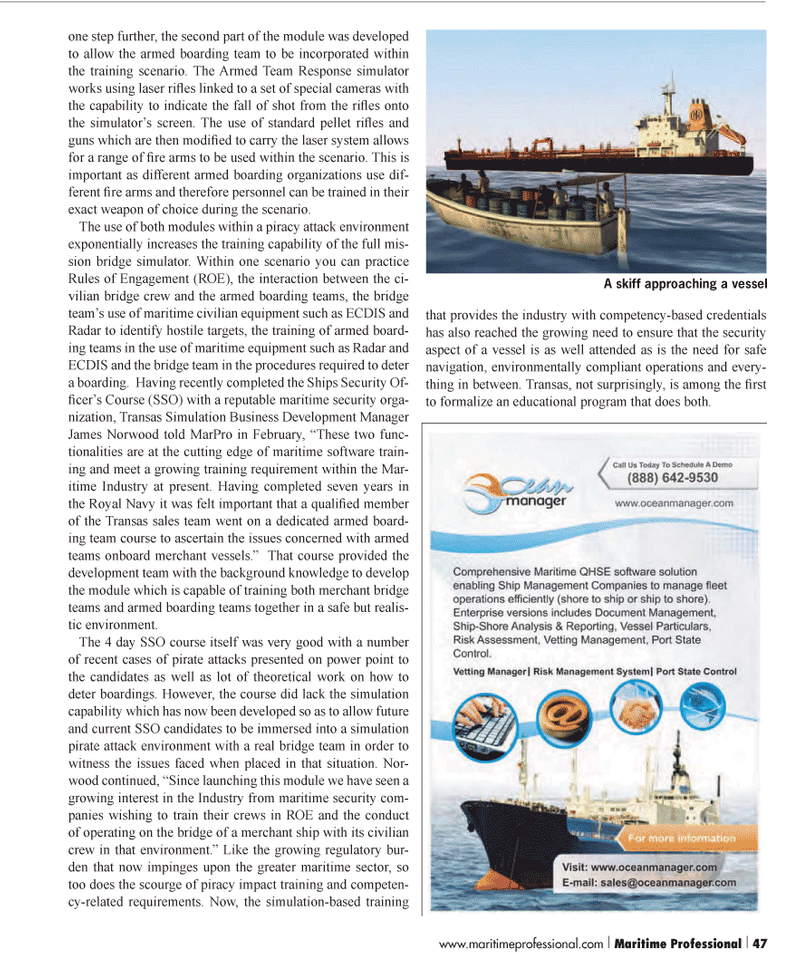
Page 47: of Maritime Logistics Professional Magazine (Q1 2012)
Training & Maritime Security
Read this page in Pdf, Flash or Html5 edition of Q1 2012 Maritime Logistics Professional Magazine
one step further, the second part of the module was developed to allow the armed boarding team to be incorporated within the training scenario. The Armed Team Response simulator works using laser ri ß es linked to a set of special cameras with the capability to indicate the fall of shot from the ri ß es onto the simulator?s screen. The use of standard pellet ri ß es and guns which are then modiÞ ed to carry the laser system allows for a range of Þ re arms to be used within the scenario. This is important as different armed boarding organizations use dif- ferent Þ re arms and therefore personnel can be trained in their exact weapon of choice during the scenario. The use of both modules within a piracy attack environment exponentially increases the training capability of the full mis- sion bridge simulator. Within one scenario you can practice Rules of Engagement (ROE), the interaction between the ci- vilian bridge crew and the armed boarding teams, the bridge team?s use of maritime civilian equipment such as ECDIS and Radar to identify hostile targets, the training of armed board- ing teams in the use of maritime equipment such as Radar and ECDIS and the bridge team in the procedures required to deter a boarding. Having recently completed the Ships Security Of- Þ cer?s Course (SSO) with a reputable maritime security orga- nization, Transas Simulation Business Development Manager James Norwood told MarPro in February, ?These two func- tionalities are at the cutting edge of maritime software train- ing and meet a growing training requirement within the Mar- itime Industry at present. Having completed seven years in the Royal Navy it was felt important that a quali Þ ed member of the Transas sales team went on a dedicated armed board- ing team course to ascertain the issues concerned with armed teams onboard merchant vessels.? That course provided the development team with the background knowledge to develop the module which is capable of training both merchant bridge teams and armed boarding teams together in a safe but realis- tic environment. The 4 day SSO course itself was very good with a number of recent cases of pirate attacks presented on power point to the candidates as well as lot of theoretical work on how to deter boardings. However, the course did lack the simulation capability which has now been developed so as to allow future and current SSO candidates to be immersed into a simulation pirate attack environment with a real bridge team in order to witness the issues faced when placed in that situation. Nor- wood continued, ?Since launching this module we have seen a growing interest in the Industry from maritime security com- panies wishing to train their crews in ROE and the conduct of operating on the bridge of a merchant ship with its civilian crew in that environment.? Like the growing regulatory bur- den that now impinges upon the greater maritime sector, so too does the scourge of piracy impact training and competen- cy-related requirements. Now, the simulation-based training that provides the industry with competency-based credentials has also reached the growing need to ensure that the security aspect of a vessel is as well attended as is the need for safe navigation, environmentally compliant operations and every- thing in between. Transas, not surprisingly, is among the Þ rst to formalize an educational program that does both. A skiff approaching a vessel www.maritimeprofessional.com | Maritime Professional | 47

 46
46

 48
48
